View current page
...more recent posts
Debate questions from today's New York Times op-ed page, annotated.
WHAT TO ASK JOHN KERRY (note the Times puts the conservative questions first)Better questions, please?
WILLIAM KRISTOL: If you now consider the war in Iraq to have been a mistake, how could you, as president, "ask a man to be the last man to die for a mistake"? (Translation: Kristol wants men to die.)
RUTH WEDGWOOD: How could we have guarded against Saddam Hussein's reckless nuclear intentions? (Assumes Saddam was a threat, recently disproven.)
VICTOR DAVIS HANSON: What precise plans do you have to induce positive changes in attitude in Iran, Lebanon and Syria? (Assumes we're the "world's cop.")
WHAT TO ASK GEORGE BUSH
MADELEINE K. ALBRIGHT: Since our direction in Iraq is obviously wrong, don't we at least need to change drivers? (Editorial masquerading as a question.)
RICHARD A. CLARKE: Under what circumstances would you authorize military action, including an invasion, to achieve regime change in Iran? (Assumes we're the world's cop.)
ARTHUR M. SCHLESINGER Jr.: What is the relation between your Christianity and that preached by the pope and by mainstream Protestants who oppose preventive war? (Philosophical question no one in the public expects a politician to answer.)
I came across Wooster Collective: A Celebration of Street Art during my reBlogging stint, and continue to be amazed by the work on the site. A visual feast, inherently post-studio, and an insult to God-given property rights. Here's Isaac "A-Number One" Hayes on a fence in Germany:

And a couple of architecture-on-architecture renderings from Paris that are merveilleux:
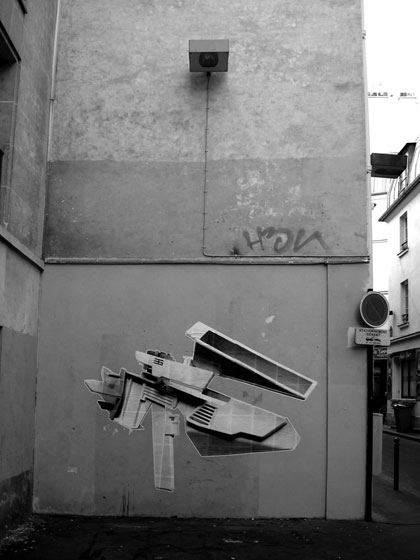
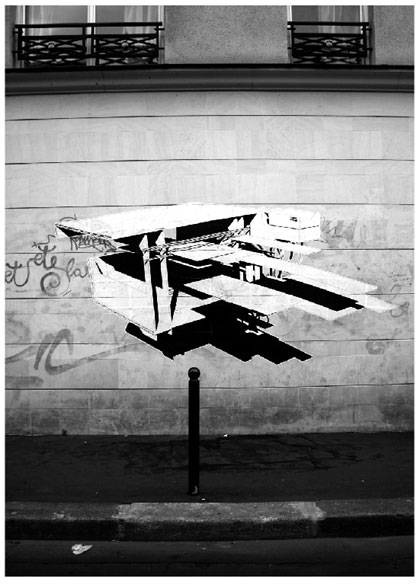
More on the train wreck that is Moog, the film. Wendy Carlos must be interview-shy. Switched-on Bach is mentioned in the movie but not her, by name. She deserves more credit (A Clockwork Orange? "Country Lane"? Tron soundtrack? C'mon!). Too much footage makes Moog's instrument look ridiculous. There's an admittedly over the top and laugh out loud funny Schaefer Beer commercial with some knucklehead doing a real ice-arena show stopper on a giant, early, multi-module Moog, climaxing with him quaffing a brew and the tag line "Schaefer: the beer to have when you're having more than one." Keith Emerson still has his two-ton Moog, and you get to see him playing it during a recent "Moog tribute night" at the BB King Theater. But it just sounds like the "Aquatarkus Variations"--nothing particularly new there. Vintage footage of Gershon Kingsley's First Moog Quartet looks as silly as that group was. Rick Wakeman makes the point, during his long-winded, bloke-down-the-pub spiel, that before the Moog, rock keyboardists weren't sexy, but were seen as behind the scenes accompanists for guitar players. But because the Moog was so loud and flashy, suddenly they could hold their own on the stage. Some of the background transition sequence music is nice. It's interesting to watch Moogs being assembled and to hear the inventor talk about them--he's quite the spiritualist, and says he intuitively knows what sounds the circuits will make. He emphasizes the importance of playing live before an audience, and seems to distrust "music made alone to be listened to by people alone," which may be why Spooky's analytical discourse on the sampler leaves him cold. A couple of other notable points: the electronic composer Vladimir Ussachevsky gave much input on the design of the mini-Moog, we learn: specifically, putting the sound generating dials (oscillators) in one rectangular group and the sound-shaping dials (envelope, filter) in another. Herb Deutsch recalls that Ussachevsky recommended not adding a keyboard, because he felt that would encourage playing the instrument in a traditional way, as opposed to discovering new sounds it was capable of, an observation that turned out to be prescient, since most people just used the Moog as a spacy organ.

John Zoller, A Happy Farm Boy in Ohio, 2001, 60 x 72 inches, acrylic and oil enamel on canvas. From the series United States: Color and Learn.
The film Moog is, I'm sorry to report, not so good. Theremin or even Modulations it's definitely not. Synthesizer inventor Robert Moog is himself a charming and highly intelligent interview subject, but the film unfortunately consists of him being flown around the globe for on-location tete-a-tetes with Musical Bores of the World. DJ Spooky holds forth with his usual spiel about sampling until it dawns on him that Moog is only feigning attention; he abruptly switches tracks and compliments him for all the analog hiphop beats his work indirectly influenced. Rick Wakeman and Bernie Worrell go on, like bad drunks at a party, about how a synthesizer is like a woman who must be coaxed, made to scream, yadda yadda. The live music depicted in the film is uniformly pretentious and blah: Stereolab, Keith Emerson, Luke Vibert and Jean-Jacques Perrey all manage not to shine. The highest spots involve not the keyboard instrument but the Theremin, which Moog got his start building. Solos by Pamelia Kurstin and Moog himself are beautiful and otherworldly--music from thin air, only two controls (pitch and volume), no moving parts, it's the soul of economy and still inherently futuristic. How did we ever lose track of the concept?
|  |
 |
|
Your so-called liberal media at work: from a New York Times review of the recent flop The Alamo on DVD:
From Touchstone, the studio that brought you "Pearl Harbor" with a happy ending, here is a bafflingly upbeat version of the battle of the Alamo, the second most famous defeat in American history. Directed by John Lee Hancock ("The Rookie") from a script by himself, Leslie Bohem ("Taken") and Stephen Gaghan ("Traffic"), the film imposes a not-so-subtle 9/11 framework on the action, with the Mexican general Santa Ana (Emilio Echevarría) strutting around in peacock military garb like Saddam Hussein.Saddam, Osama bin Laden, whatever. But wait, there's more Bush propaganda:
The 200 brave men of the Alamo go down with all due spectacle, but then the film tacks on a 30-minute coda in which Houston leads a victorious invasion spurred by the famous words "Remember the Alamo" - presented as 1836's anticipation of President Bush's ground zero speech, "The people who knocked down these buildings will hear all of us soon."I guess we know who the reviewer, Dave Kehr, is voting for.
Music-and-video outfit x-eleven burned brightly in the Dallas rave scene from 1992-1995, with frequent radio play on Jeff K's Edge Club program, inclusion in the Tales From the Edge CD series ("Texas Techno" installment), and appearances at major rave events. Their fast, scintillating techno tracks never quite gelled into a CD's worth of material, at least for perfectionist Gary Wicker, who wrote and performed the music. Strong nods to prog-rock and the industrial canon distinguish it from more purist or jazzy Detroit-style techno; Wicker mentions 808 State as an inspiration but I'd say Orbital if I had to compare it to anything. Wicker's amphetamine-fueled contrapuntal keyboards are in many ways the opposite of acid-house minimalism; one could envision a caped Rick Wakeman playing some of these baroque riffs, accompanied with grooving dance-floor bass and slightly incongruous party-hearty samples of kids saying "C'mon!" and "Let's do it!" The music doesn't quite fit into the Simon Reynolds standard techno timeline: it's an intriguing side-stream to what was happening further north and across the pond.
In '96 Wicker sold all his equipment and never looked back at his musical career, at least until last year, when he put the entire x-eleven catalog online, with assiduously detailed commentary, in what he calls "a sort of paean to the spirit of failure." The site has literary as well as musical interest, with Wicker narrating his own short career in the reflective tones of a sociological case study--a bemused audio-linguistic meditation on artistic aspirations and the messy realities of a being a group navigating the world of public performance and recording. (Personally I think he is seduced to this day by the capitalist paradigm that confuses business failure with creative failure--the latter this is definitely not.) With the reckless generosity of a recovering musician (who says he's still working, but not in this style), Wicker invites you to "download [all the x-eleven tracks as] .mp3 files, load them into your iPods, burn them onto CDs, do with them as you will." While you're listening you can read his fact-crammed commentary, a veritable how-to of basement keyboard and drum techniques. See, for example, this blurb for the 1992 track "Through the Ether":
This track opens with a filter-sweeped OB-8 sixteenth-note figure and a basic four-on-the-floor beat. Shortly thereafter, the members of Yes are digitally tricked into playing a portion of their biggest hit backwards, then forwards, then backwards again by a crafty ASR10M. Not content to humble just one great prog-rock act, the ASR10M then corners Robert Fripp's guitar, lassoes it and forces it to play a strangely happy melody that would be right at home amongst the talking mushrooms in an episode of "H.R. Pufnstuf." A bouncy CZ10M mallet part (inspired by Absolut's "X Ray My Love") soon takes over lead duty as most of the rhythm track drops away, leaving only a TR909 bass drum whose dotted-sixteenth triplet pattern indicates that it's caught a case of the giggles. A jazz drum loop soon joins in the fun, followed a few bars later by the rest of the drums and a stereo-phased ESQ-1 white noise bit. A tight snare drum roll announces the return of Fripp's regal-sounding looped guitar, and a confused Matrix 6R, still playing the theme from "Past Passion," wanders in from the next room. The mallet part eventually returns, accompanied by ascending arpeggios from the Matrix 6R and some stereo delay trickery, and we're soon back in Sid & Marty Krofft territory. The six-note "Past Passion" theme makes another final appearance before the track draws to a close.
Other standout tracks on the site include "Burn it Up" and "Past Passion," but they're all worth a listen. It's the apotheosis of geeky keyboard tech--geeky but cool, at least in my biased opinion as a fan who until recently had only a few nuggets but just found the mother lode.
Update, December 2014: The X-Eleven links above are dead but the group has a page on bandcamp.Blogger Billmon (of the "Whiskey Bar" site) disappeared about a month ago and recently resurfaced on the op-ed page of the LA Times, griping that bloggers are being co-opted through advertising and gradually absorbed into the major media. It's definitely happened here; I'm constantly being offered plum sponsorship if I would just stick to one subject. (Kidding.) Billmon makes one good point: "The political blogosphere already has a bad habit of chasing the scandal du jour. This election season, that's meant a laser-like focus on such profound matters as the mysteries of Bush's National Guard service or whether John Kerry deserved his Vietnam War medals. Meanwhile, more unsettling (and important) stories — like the Abu Ghraib prison scandal or the great Iraq weapons-of-mass-destruction snipe hunt — quietly disappear down the media memory hole. And bloggers either can't, or won't, dig them back out again."
But he's just as guilty of focusing on A-list bloggers as he says the media is. Instead of using his moment in the sun to steer readers to less-appreciated venues, he kvetches about a handful of peers he perceives as "making it." Like we give a flip. James Poniewozik used to be a regular, hilarious read for me in Salon, but since he became Time's TV critic I haven't read a single word he's written. (I just never read Time.) The same will happen when Atrios or Kos cross over to the dark side. Or Billmon, if he becomes a "pundit" and doesn't restart his blog.
(thanks to drat fink for the LA Times link--registration probably required)
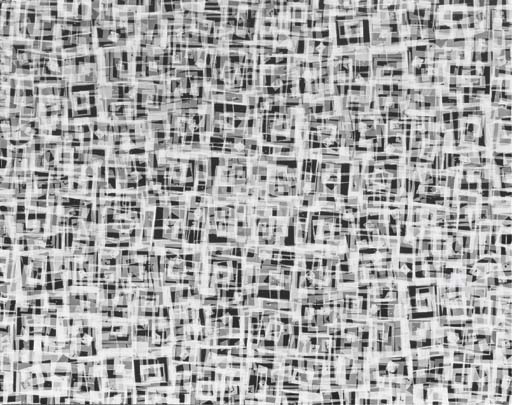
Via bloggy, Christie's, and Sir Reggie Dwight's collection comes this Harry Callahan image, titled Collage, Chicago, 1957, a small gelatin silver print. An uneducated guess is these are superimposed negatives of an array of photos spread out on Callahan's wall or floor (which may or may not actually have been glued together in real space). Interesting the way the photo picks up the rhythms of the Abstract Expressionist painting of the time--e.g. Mark Tobey, Bradley Walker Tomlin. Back then this was was just considered "art" but now we see it as all of a piece with 50s textile design and magazine illustration. What will the "art of today" be all of a piece with, I wonder?
In the comments to an earlier post, Aaron Yassin says: "Although I don't mind a few New Dumb Little Paintings here and there (some of them can be pretty cute) I'm not as sympathetic as you or Jerry Saltz are to the genre. I'm actually more mystified by the continued proliferation of the form and view it as one more sign that we are really in the midst of a mannerist period." He asks what I think is important about the genre.
First, don't give too much weight to Saltz's opinion since he has what art historiographer James Elkins calls a "positionless position" on art. The brief for bad painting, however, has remained fairly strong since it was first identified by Marcia Tucker and others in the late 70s. Here's the gist of an argument: Technological developments in "imaging" (first photography, now digital tools) are in the process of making painting as historic as hot lead typesetting, whether we like it or not, and there are only two ways it can go now. It can merge into technological practice and/or it can be the most idiosyncratic, unco-optable form of personal expression. "Mannerist" implies decadence but idiosyncratic personal expression is absolutely vital and essential in a world dominated by mass-(re)produced media. Jim Shaw's "Thrift Store Paintings" show at Metro Pictures was a landmark because it harnessed the power of many individuals' "one good painting" (good meaning punchy or hard-to-forget) and also presaged the role of the artist as curator of such phenomena, an increasingly common practice on the Web. I could go on but that's it in a nutshell. To me, "mannerism" is the postmodern AbEx painting at Von Lintel gallery in Chelsea.
In this post Adam Greenfield points out a recent bit of Eyebeam reBlogging to illustrate the damage that resyndication feeds could do to Google ranking and giving-credit-where-credit-is-due. Specifically, when Eyebeam reBlogged an item about Jim Davies' Pac-Man Paintings Page, it did not assign the primary, "top of the post" link to the original source but rather to a downstream reblogger. Thus, instead of clicking surfers through to Davies' page, the top link takes them to a secondary source. Greenfield believes such practices muddy the web waters and fears that ultimately a reBlogger could beat out Davies, the content originator, for top Google ranking.
I was the reBlogger at the time so here's an explanation. First, in defense of the Eyebeam reBlog software, it does give the reBlogger a choice which link to use for "top of the post" status, so it's not purely robotic. I chose the link I chose (we-make-money-not-art's reblogging of the item) because w-m-m-n-a had picked and (as best I can recall) resized the photo accompanying the Davies plug and added (admittedly very slight) editorial commentary. I figured that since Davies was being reBlogged so many times he'd ultimately get his due (which at the moment appears to be slashdotting), and I'd give credit to the reblogger who packaged the item in a way most to my taste. And, to be perfectly honest, I thought Davies' art was topical and only mildly amusing so this was my way of hedging a critical endorsement.
As far as Google getting skewed by my capriciousness, jeez, who cares? It's an erratic search measure at best and plain screwy as a measure of intellectual worth. Thanks to Google, my current largest hit-getter is a drawing of gay furry porn I linked to over two years ago, to make a minor point about, ironically, the vernacular side of the Web mooting earnest new media initiatives. As far as I know, I'm the only person who ever linked to it, and it gets disproportionate attention because Google Images pulls it up as an example of the hugely popular "yaoi" (male-male manga) search term. That comes from the URL, not me--I didn't even know the term in June 2002 (in fact, I thought the furries in question were a male and a female). I guess my point is that sometimes it only takes one link to make something "a hit," and getting credit as a "discoverer" of an artwork can result in a tidal wave of unwanted traffic. Not quite the same, honor-wise, as publishing an article in a peer-reviewed journal, for either the critic or the critiqued. To conclude, as David Byrne once said of the government, "Don't worry about Google."
From Daniel Albright's Quantum Poetics (Cambridge University Press 1997), p. 191:
For several years before writing Hugh Selwyn Mauberly, Ezra Pound had earned money by writing criticism, with varying degrees of good humor and bitterness. Much of this criticism was published pseudonymously:I am writing regularly for [Orage, editor of The New Age] as B. H. Dias and Wm. Atheling. The former on art, where E. P. would be hopelessly suspect of Vorticist Propaganda, and the elderly Atheling on music because no one writer should publicly appear to know about everything. These wind shields are to be kept secret. Dias only puts over as much as the N[ew].A[ge]. reader is supposed to be able to stand. (Ezra Pound and the Visual Arts, p. xxii [1918])Clearly these personae are conventional critics generated by a general subtraction of talent, vigor, and idiosyncrasy. (Though of course they still managed to give a good deal of offense--particularly because of Atheling's invectives against the piano.) Atheling is elderly, while Dias is--at least on a few occasions--a fuddy-duddy horrified by certain advanced Modernist ideas, such as those of Ezra Pound. As Dias wrote to The New Age:There is no use arguing with these people. There is no use trying to make them understand [that]...sculpture...is an art of form, whose language is form... Mr. Ezra Pound attempted some such explanation in your paper years ago; it only produced a riot. But, then, he expressed himself very badly and in the jargon of his horrible vortex. (Ezra Pound and the Visual Arts, p. 36 [1918])
I first heard the music of jenghizhan (aka John Parker) at the Brooklyn space vertexList, and described it enthusiastically here as "mysterious, sexily-filtered ambient industrial keyboards." He has since posted those performances on this page of his website, as "live improvisation with the Elektron Monomachine." Track 4 is one of my favorites, and I did a "remix," consisting solely of lopping off the intro and cutting straight to the monster, four-note hook that first grabbed my attention: [4.7 MB .mp3].
Later I heard him perform with Man from Planet Risk, his duo with Cave Precise (Ron Ramey), both in a live club setting and on CD. In a post on the band I commented on the differences between their live and studio sounds:
For all its echo-y horror soundtrack atmospherics and Black Sab-like bass riffs, the CD is much lighter [than the live playing]: the beats are spryer, with turntable twists & jazzy piano riffs livening up the doom and gloom. "Triphop" comes to mind because the sound is truly trippy: jenghizkhan approaches music like a painter (and is in fact a visual artist, exhibiting under his non-nom de plume), taking advantage of all the filtering and timestretching capabilities of modern keyboard tech to make layers of artfully mangled sound. Imagine Ennio Morricone eclectism shot through with the kind of dreamy, smeared psychedelia of San Francisco post-punkers Chrome, or the European hardcore tech of The Mover set to a hiphop beat.Since then, I've listened to jenghizhan's solo CDs Hooden Knooks and Brooklyn Sucks. It's great stuff, what the late lamented Throb records would file under "braindance" and what I would call "art electro." By way of comparison, I went back and listened to the Ischemic Folks compilation, which many considered a watershed for this kind of intensely digital electronic music, and found I like jenghizkhan better. Except for a couple of lush Richard Devine compositions, the IF CD is brittle and analytical, with too much of the Miami Bass parent DNA decanted out in the name of art.
Mixed in with jenghizkhan's trademark doomcore riffs one hears a lot of humor, and a strong melodic sense even when he's furthest out there in the drill-and-bass, sound-bending zone. As audio abstraction it's more frenetic de Kooning than faux-febrile Richter, and for all jk's insistence on "modern digital synthesis" over retro styles and sampling (more on this soon), his compositions have the verve and warm texture of early analog and tape recorder music (e.g., Mario Davidovsky, Otto Luening, Richard Maxfield), as opposed to the rather cool "glitch" sound of Oval, Phoenicia, et al. Check out these tracks from the CDs: "Sidewinder Circus" [1.4 MB (excerpt) .mp3], where the digitally scrambled phrase "sidewinder heat-seeking missile" sniggles in and out of overdriven-soundcard-like raunch, and "Outlet Nightjar" [ 3.56 MB .mp3], in which a synthetic bowed string keeps sounding the same ridiculous note in counterpoint to a heavily reverbed pseudo-guitar.
[coming soon: Part Two--how Man from Planet Risk differs from jenghizkhan solo work, and a discussion of gear]
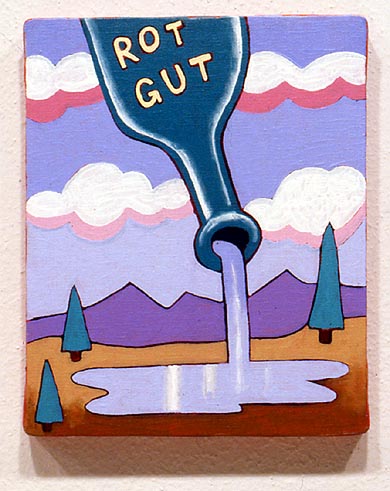
If I'm sympathetic to the New Dumb Little Painting genre it's because I've done my share of them over the years. Here's one from '91: Rot Gut, acrylic on canvas, 10 X 8 inches, currently hanging in the Louvre in Paris, France.
Today is my last day reBlogging for the Eyebeam reBlog. Tomorrow the Eyebeamers will introduce my successor, Tim Shey, who will take it from here. After three weeks monitoring about 100 blog feeds and reposting 15-20 items per day (often with added pictures, text, or gratuitous comments), I would now like to articulate my personal reBlogging philosophy--hopefully you're sitting down. Here are my thoughts, for future reBloggers (and reBlog readers) to take or leave:
1. reBlogging is definitely an art, somewhere between curating and editing. I believe the Eyebeam reBlog can be as important and genre-defining as any of the major umbrella tech sites, umbrella art sites (if those existed) or heaven forbid, regular news sources, as long as original material from a pool of steady dedicated bloggers is given equal weight to clips. The purely anecdotal has value, as does free lance reporting. Accordingly, I tried to emphasize unique, personal blog writing and research over news items recycled from big media sources. By and large I did not reBlog slashdot, boingboing or kottke, assuming that most people were looking at them anyway. I also avoided the major media feeds, such as NY Times, Yahoo, Wired, for the same reason.Because of the rotation system, personal guidelines such as these won't harden into rules, resulting in the "soft bigotry of voluntarism." I look forward to following the reBlog after I Ieave, and invite everyone to visit my personal blog, where posting is about to increase markedly. I'll probably reBlog a few more items today, but wanted to get this up.
2. I favored items with text or pictures over blind links with pithy 3-word captions.
3. I tried to keep a balance of tech and art writing.
4. I included a heftier dose of politics because the major media are failing us in that regard and we have to do what we can.
5. I added a few feeds where people are posting original art to the Web: Look, See; SCREENFULL; Wooster Art Collective.
6. I was disappointed in the music coverage out there. A lot of electronic dance bloggers, for example, don't have RSS feeds or seem to be in a post-coital slump after they all found and linked to each other about two years ago.
[Obviously this was written with self-reBlogging in mind.]
I have an animated .GIF in the online exhibition "Sunday Afternoon," curated by MatCh-Art (Matthew Fisher and Christina Vassallo). The show of approximately 25 artists, described as "an interdisciplinary exploration of leisure, love and obligations," showcases, among other things, what Jerry Saltz has called "puberty escapism" and what I would call The New Dumb Little Painting, a style sweeping New York, if not the world. I don't mean the term disparagingly at all: antecedents would be Laura Owens and Karen Kilimnick and the reigning queen, I suppose, would be Dana Schutz (even though her paintings aren't very little). The style is marked by faux naive paint handling, disguising sharp, emotionally punchy, and/or socially-tinged observations; MatCh-Art and its earlier incarnations specialize in fairly intimate and ambiguous twists on the genre. Here's a great example, from the "Sunday Afternoon" show, Jeffrey Lutonsky's Fuck Ken Schrader, 2004, ink and pencil on paper, 14 X 17 inches:
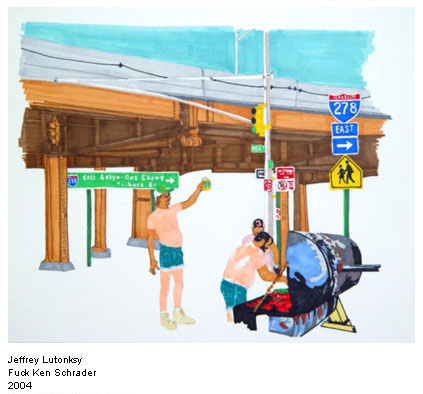
Did you read Robert Novak's recent column? The Bush inner circle appears to be telegraphing to the non-neocon righties that they plan to pull out of Iraq soon after the election! While in the meantime Bush continues to talk tough for the security moms.
Well-placed sources in the administration are confident Bush's decision will be to get out. They believe that is the recommendation of his national security team and would be the recommendation of second-term officials. An informed guess might have Condoleezza Rice as secretary of state, Paul Wolfowitz as defense secretary and Stephen Hadley as national security adviser. According to my sources, all would opt for a withdrawal.Novak is a paleoconservative and kinda sorta opposed the invasion so this may be wishful thinking on his part. But I don't think so. The neocons may have decided this thing isn't winnable and are looking to save their front man so they can fight (Iran) another day. I wish I could say Kerry/Edwards were an antidote to this craven duplicity but they also speak with bifurcated tongue on the issue. "We'll win this thing with European allies" and "We'll be out in four years" are just a lame campaign message.
Getting out now would not end expensive U.S. reconstruction of Iraq, and certainly would not stop the fighting. Without U.S. troops, the civil war cited as the worst-case outcome by the recently leaked National Intelligence Estimate would be a reality. It would then take a resolute president to stand aside while Iraqis battle it out.
My print criticism continues to surface on the Web like submerged bodies rising in a Meadowlands pond. Here's my Artforum review of Randy Wray's 1996 Kagan Martos exhibition. I enjoyed looking at Wray's website, about which more later. Missed the last couple of shows, unfortunately, but in the paintings I've seen, the tension between abrupt bursts of ideas and obsessive time-filling noodling within the same piece is compelling. It's tempting to say they're Seinfeldian in that no subject becomes the subject. I still think I prefer the earlier, punchier works, but it's fascinating watching his thought process...mature? deepen? not sure yet (you, too, can follow this development by paging though the slightly-too-small but kilobyte-intensive website pics). He does use the computer now for developing ideas, but too much could be made of that--they're still about painting, sculpting, drawing, and paint-by-number handicrafts. You don't feel much "cyber" in the work--it could just as easily be elaborate Polke-esque stencilling.
Old scores: this piece, Nest, was the image I wanted to accompany my Artforum review, instead of the one they ran (it was the dealers' fault for sending in something else). This would have popped off the page in AF's black and white postage stamp format.
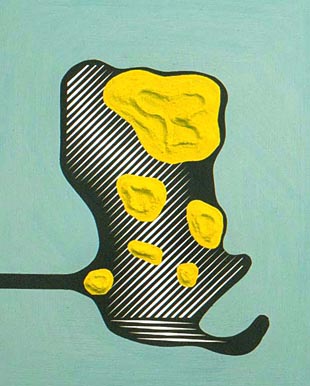
Trax Records, the seminal Chicago house music label, just re-released some vintage recordings, and the Seattle Weekly's review of them is worth a read. I just purchased Acid Classics and my jaw elevatored down to hear this music I completely missed when it came out in '86 (!) through 1990. (I knew about House but had no reliable way to get my hands on the vinyl.) By now we've heard these moves a million times--the trancy squiggle of the Roland TB-303 is a musical institution--but these early, stripped-down psychedelic funk engines still sound radical. "Acid" is the most techno-y side of house, and the beats are as minimal as it gets, but still seductive and completely up to date. There's simply no comparison between this music and the "industrial" style of pre-techno that was appearing around the same time--Front 242, Nitzer Ebb, Single Gun Theory--whose beats were much more pounding, metallic, obvious, and, now, dated. (Although I still have a soft spot for Nitzer Ebb.) Laurent X's "Machines" and Adonis' "Two the Max" are brilliant.
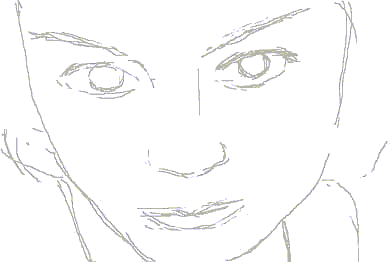
In a comment to the previous post, Brent questions whether Chris Ashley's stationary HTML drawing and jimpunk's moving .GIF are comparable or compatible on the same page. My usual quip about showing video next to paintings in a gallery setting is that it's like bringing a baby to a wedding, but the browser is the great equalizer. A few more line breaks were added to the post so the pieces aren't quite so close together, but otherwise, yeah, I think they have more in common than not as art non-objects. Although neither artist is an Op artist in the old '60s sense, the pieces exploit optical tricks over and above their plain formal appeal: illusory depth in the Ashley and quite literal vibration in the jp. Moreover, they are fresh takes on the grid and opticality, which the New York Times and the Village Voice love to dismiss as the concerns of a bygone generation, in spite of all evidence to the contrary (e.g., the Infinite Fill show.)
Chris Ashley - Untitled (Blue and Green) 18, 2004, HTML, 320 x 240 pixels:
jimpunk, ( [ ] ), 2004 animated .GIF and HTML:
   |
Re-reBlogging a couple of items from yesterday. More commentary will eventually be added, perhaps when I return to decelerated blogging life a few days hence. Ashley's drawing is straight-up HTML, and jimpunk's piece uses HTML to vertically stretch this gif (
UPDATE: This "website bricabrac" is some Apple "loading--please wait" icon thingy that's been turned from pale blue to black and white. I'm surprised no one told me I was revealing my Apple-ignorance (again).
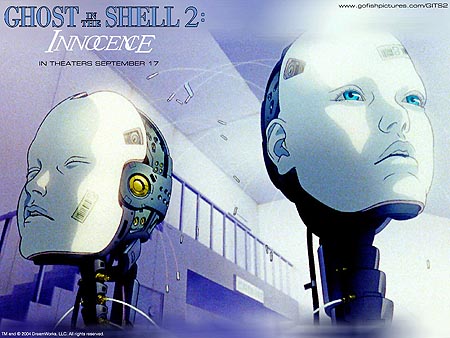
Official website
Spoiler-ridden interview with director Mamoru Oshii:
From the trailer it looks like a lot of CGI machinery awkwardly mixed in with character drawing. The story idea seems lifted straight from Armitage III, only with more of that heavy out-of-body stuff (and melancholy) that is Oshii's specialty. I mean, the man didn't look the interviewer in the eye once! (Thanks to del.icio.us/moth23 for the link).The original Ghost in the Shell, adapted from a manga (Japanese novel in comic-book form) by Shirow Masamune, inspired Andy and Larry Wachowski to make The Matrix [what didn't? --TM] and topped stateside video sales in 1996. Innocence, which premiered at Cannes last spring, catches up with Batou, a cyborg detective who journeys through a futuristic cityscape to crack the case of the killer gynoids (a term coined by Oshii). The prostitute ring of robotic Geisha-like sex-toys turns out to be masterminded by Kim, a crafty doll who fends off the investigation by implanting false experiences into Batou's "e-brain."
The sleuth eventually reunites with the Major, who exited her "shell" to become pure soul -- a ghost -- at the end of the first installment. Together they rescue hapless gynoids who become animated by having the ghosts of real girls "dubbed" into their bisque-coated physiques. In between his battles with Yakuza thugs, toxic firewalls and homicidally programmed assassins, Batou, Oshii's self-proclaimed alter ego, discusses Descartes, quotes Shelley and cites biblical passages.
UPDATE: Saw this on Sept. 21. It's beautiful to look at, like Peter Greenaway's Prospero's Books, which I also fell asleep in. Really don't like the combination of CGI (with obvious photoshop textures) and cartoon anime.

Above: John Pomara, oil on paper, ca. 1987. Speaking of painters braving the switch to 1s and 0s, the piece above is what Pomara was doing in '86 and '87 (gorgeously painted semi-abstractions with roots in AbEx, the east village, and '60s sci fi book covers) and below is a detail of a recent piece:
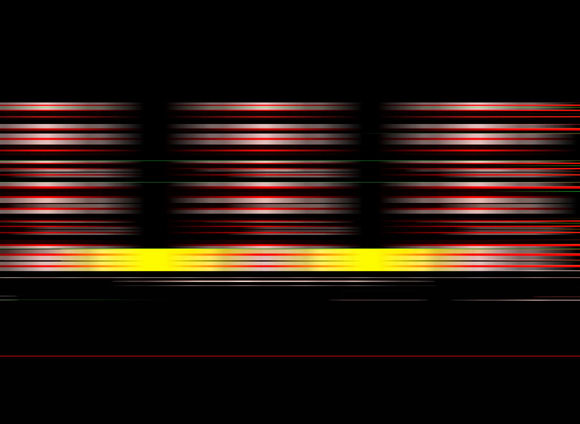
Pomara starts with a pixelated blow up detail of an image such as a face and gets busy crunching in an imaging program, refining and deforming and refining until something that looks like modernist architecture emerges. He does still paint, and these images are used as stencils in that process and also printed out as stand-alone photo-works. I maintain that a painterly eye transcends media and we're too fixated on the physical stuff: obviously output is important, and that's something we're all wrestling with. I'm confident that solutions will continue to be found that will save us from the dreaded fate of becoming printmakers. Calling the output "photography" is one conceptual end-run around the problem.
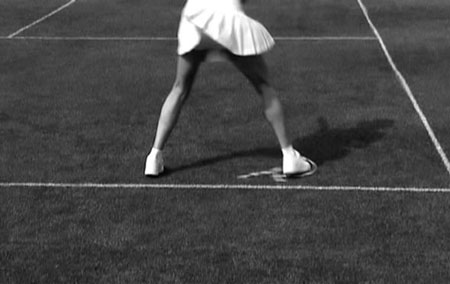
Diana Kingsley, Court Disaster, 2000-04, still from 2.5 min. loop, DVD on video monitor
New York artist Diana Kingsley, who I've I've written about a few times, just concluded a show at Leo Castelli, after earlier appearances at Derek Eller and Bellwether. The New Yorker reviewed it during its July/August run, and this week, Artnet observes: "With its visual reductiveness, Kingsley's work has the starkness of pulp fiction, where bare facts and descriptions set a mood more than they add up to a story. Her video narratives are tenuous, threatening to wink out and leave us with still imagery." To which I would add that the videos, like her still imagery, seem calm and innocuous at first but each contains some hint of the ominous, a mini-disaster waiting to happen.
More of the conversation Chris Ashley and I are having on painting and technology, from comments to an earlier post:
Chris: You say, "As for painting, I have no plans to do it--I'm more interested in the problem-solving of how to make interesting, resonant, stand-alone objects with the computer, printers, photocopiers, etc., and intertwining that practice with purely online things like animated GIFs." So, you're not exactly saying that you'll never paint. And I'm not trying to make you. I guess I'm wondering if you're leaving the option open so that if, at some point, a situation presents itself that tells you that the meaning you're working on requires the use of paint, whether, say, as enhancement or contrast, or for expression or irony, would you recognize that and not just follow a rule that says no paint, but instead follow the work and use paint?
And when I read your thoughts, "By 'real world grit' I was referring to the legal pad, office paper, product boxes and such that I've incorporated into the work," you're referring to materials that have in themselves a whole load of received meaning, and that could have, for some viewers, a kind of grit, or romance, or revulsion. You know, is it possible that at some point the viewer says, "Oh, the use of office materials in art is dead," as has been said about painting, as will be said about installations, and large photos mounted on aluminum panels, and the creation of characters for video or performance, and whatever else you're going to find in all of the galleries everywhere this "season."
I'm just trying to make the obvious point that probably no one is arguing against anyway that paint, in the many ways it's possible to use it, is, and will continue to be, a viable technology, whereas someday my HTML drawings will no longer be viewed in their native environment. The technology will fade. And I'll have no control over that. In 25 years using MacPaint will probably be pretty hard, but you'll always be able to buy a ten-color watercolor set at a stationary or educational supply store.
Tom:"Oh, the use of office materials in art is dead,"
My use of those materials died around 2000, with my permatemp gig. (Which is not say I might not use them again if I got a similar gig, but right now I'm working with "home consumer technology.") The criterion shouldn't be hipness so much as relevance: there's a history of artists working with the newest technologies (e.g., ground pigment) with a concomitant falling off of interest in older technologies (smearing roots on the cave wall). I'm more interested in applying what I would call a "painterly" approach to tech than painting itself (the physical side of which I never liked that much anyway). I would say HTML drawings have as good a chance of surviving (via being saved on hard drives, etc.) as physical art objects (many of which end up in landfills and moldering in relatives' basements). And as for media surviving, who cares what happens to art in 25 years?
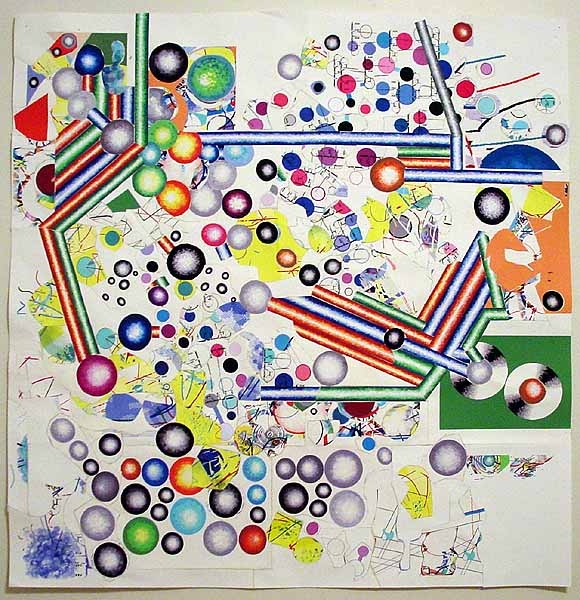
Expanded version of a piece I did last year; I added about 8 inches to the what used to be the top and turned the format from a rectangle to a square. I'm calling it Van Der Graaf Flux; the whole thing is meandering conceptually and may not be finished (meandering being, I think, the subject matter). It has some Russian constructivist elements. Those spinning disc things over on the right are a design I saw years ago in a Popova (?) painting depicting rolls of silk in a silk mill, seen end-on; I've recycled it quite a bit. All the imagery is drawn in MSPaintbrush and MSPaint; the paper is repeatedly run through the printer, cut apart with scissors, and taped back together; the back of the piece is a dense network of linen tape holding the whole thing together. See? Kind of ugly, but here it is (flipped).
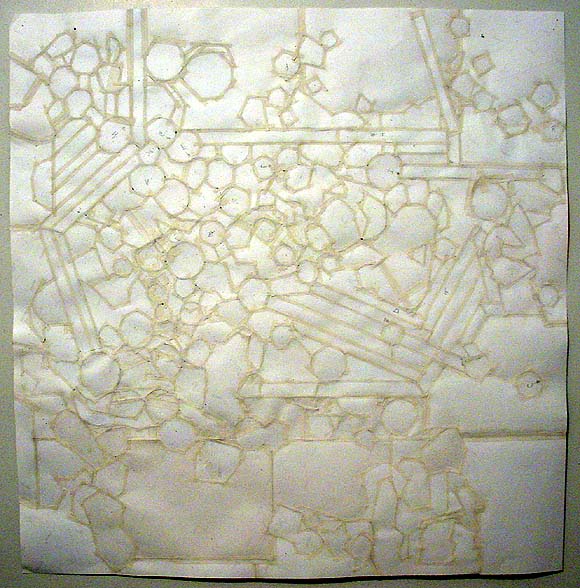
Here's a macro detail, which should banish any remaining illusions that this piece is "computer-slick":
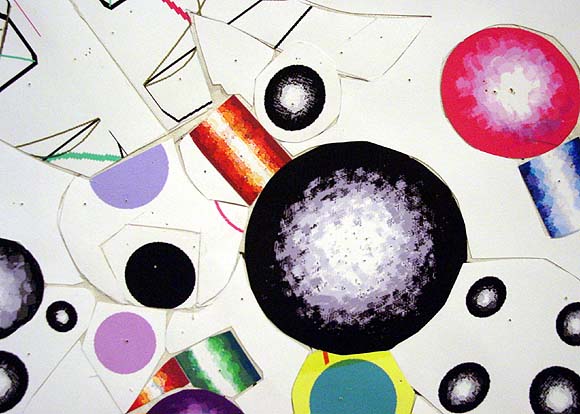
Towers of Light vs The Birds
James Wagner asks about the flecks in the light beams in this photo he took of yesterday's Tribute in Light 9/11 memorial. Via alex (scroll down): "This is what birders were afraid of: this year's Tribute in Light display coincided with a big migrant flight. Too bad for the birds. Here's a report received from bird advocate Rebekah Creshkoff (a non-birder friend who saw the display thought that there was "glitter" in the light beams; that was birds.)"
I was at the Tribute in Light briefly tonight, from about 10:30 to 11. I didn't see our volunteer Brooke, but I sure hope she or Eileen or Denise had/have a camera. I didn't, but what's going on down there should be documented.Just wait till they fire up those big wind turbines in the Freedom Tower.THOUSANDS of birds were behaviorally trapped in the columns of light. The beams were visibly filled with birds for their entire height, looking like clouds of bugs. Their twittering was audible.
Their brightly illuminated bodies were reflected in the windows of nearby buildings -- 3 World Financial Center and the movie theatre. The light was so bright, some birds looked as though they were on fire.
There were so many birds, it was impossible to track any one individual for any length of time. I did see one bird that circled in and out of the uptown beam six times before I lost track. Each time, the bird stayed in the light for from 3 to 9 seconds.
The lowest 30 feet or so of light had moths instead of birds. Fantastic numbers of moths were attracted to surface of the big lamps. Assistants (wearing sunglasses) frequently wiped the surface of the lights with a cloth; even so, there would be smoke from all the moth bodies just moments later. I saw one bird lower down (apparently) escape the beams.
The birds were visible to the naked eye as sparkling motes floating in the light from Barrow St., about a mile or so uptown.
I found all this extremely disturbing. It takes a songbird about a week to lay down a gram of fat -- fuel for its long-distance migration. That fat will carry it about 120 miles. How much fat are they wasting flying around in those beams, only to have to (best case) spend the next several days refueling in food- and habitat-poor lower Manhattan?
The beams put me in mind of the old-time ceilometers -- beams of light formerly used at airports to measure the height of the cloud cover. Many significant birds kills were documented at ceilometers. I am attaching a paper I wrote for the organizers of the first Tribute in Light, which references ceilometer data.
The good news is, the lights will be off tomorrow. But is the human value of the Tribute in Light really worth imperiling thousands of birds -- and incinerating God knows how many moths?
Rebekah
I posted this diptych a while back, and attempted to explain what was going on in the piece when someone asked what the hell it was. Apropos of a more recent discussion, I realize now that mere blabbery words are no substitute for a revealing, demystifying, letting it all hang out, kinda looks like shit back of the piece shot. I didn't want to do this before because it destroys the elegant aura I worked so hard to give this cheaply executed work. I don't know why I'm doing it now--you wouldn't see this in a gallery unless you took it down off the wall, why show it online? (By the way, the times I've shown these pieces publicly I've stretched a rectangle of silk behind the paper so no one can poke a finger through it--but I don't believe in glueing it down or pouring resin all over it to "collector-ify" it, a la Fred Tomaselli.)
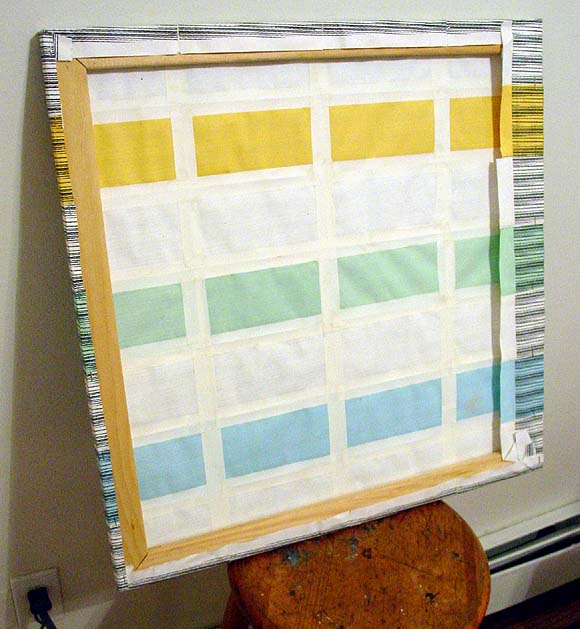
Another recycled reBlog post:
Matt Pyke recently left tDR [The Designers Republic --TM] to join Transistor Studios - the most excellent demo reel of his is here, and his latest project, a music video for Nuno Felipe, can be seen here. Good stuff!The Designers Republic was the vanguard of the graphics revolution (or what might be called the "vector revolution" for its use of Illustrator, Flash, and the like), most conspicuous in electronic dance music packaging but also embraced by Globo Youth Marketing Capitalism. It's nice to put a name to a product, even if tDR was supposed to be about anonymity and collectivity. I didn't watch the music video but the demo reel is pretty mind-blowing. Sorry to always keep harping on Jeremy Blake, but this is better, innit? I liked Blake during his Morris Louis phase (which PT Anderson picked up on and then Blake abruptly dropped) but for a full-service digital collage artist, Pike is doing more tricky and I would say paradigmatic stuff. It's just that one is "high art" and was in the Whitney three times in as many years and the other is "low art" that is probably making the producer oodles of money--as clear an argument as I've seen for the need to rethink the distinction, at least where digital media are concerned.
via KALIBER1000
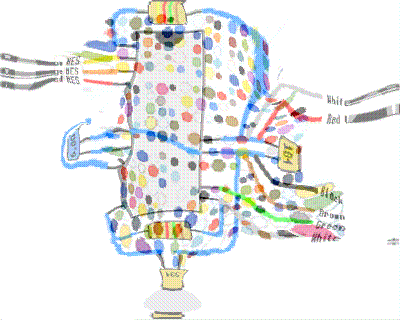
jimpunk did a nice animated .GIF of my "logo" morphing into the wiring diagram from my reBlog post "How to make a Nintendo controller into a PC joystick."

Sarah Hollis Perry, At Home (blue chair), chair upholstered with New York Times bags
Opening Friday, Sept 10th, 8pm, at Flux Factory, Long Island City, NY, running from September 10 - 25, 2004:
REFUSE: functional art objects and music made from waste.
Project statement
There is an alchemical process that takes place when waste is converted into something useful. REFUSE is a collection of work by artists who apply this process to castaway raw materials reshaped into functional art objects and sound sculptures. The exhibit will include pieces whose emphasis is on form and function, making scavenged material an integral, possibly unapparent element of the work through skilled transmutation. An apparent dwelling space within the gallery will be assembled with pieces ranging from dresses woven from cassette tape ribbon (Alyce Santoro), a chair reupholstered with woven blue new york times bags (Sarah Hollis Perry), chairs fashioned from recycled road signs (Boris Bally) and tables crafted from scrap wood (Scrapile). Several Interactive sound sculptures and musical instruments made from waste will be placed throughout the gallery providing a sonic backdrop for the space.
Featuring works by Boris Bally (borisbally.com), Lea Bogdan, Ken Butler, Peggy Diggs, Joy Halsted, Nikolai Moderbacher (nikolaim.com), Cynthia Norton, John Parker (eyekhan.com), Sarah Hollis Perry, Philadelphia Dumpster Divers Neil Benson and Steve Thompson, Alyce Santoro (alycesantoro.com), SCRAPILE (bettencourtwood.com), Colleen Smiley, Meghan Trainor, Crispin Webb (crispinwebb.com), Peter Whitehead (healthyarts.com), Isac Zal (isaczal.com), and more.
[Just a few thoughts, based on surfing around some of the websites: working with landfill material is tricky; it can be politically edgy but it can also get bogged down in the sentimentality of "old stuff." There are a million undistinguished artists all over the world making assemblage type works with discarded junk; what separates them from a Yayoi Kusama or a Robert Rauschenberg is a question curators should be asking. Sarah Hollis Perry, maker of the blue chair above, appears to have swallowed Kusama whole but the cheekiness of using Times bags--the discarded wrapper or "invisible brand" of the "intellectual paper"--makes the work seem up to date. (I say seem because I'm only looking at the jpeg.) Other participants in the show might be veering dangerously close to the sentimental school, and there appears to be at least one designer making a straight commercial product out of post-consumer materials. Nothing wrong with that as long as the curation takes these distinctions into account. Yeah, I know, no one asked me to criticize the show, I'm just covering my ass because I haven't seen it. --TM)
The American Dream

This is my downstairs neighbor standing on what used to be his patio deck. The property owner next door decided to squeeze a few more rental dollars out of his 3-story building by lowering the level of his back yard ten feet and adding a fourth apartment in the basement. Construction has been slow: he did the digging a year ago and never shored up the excavated pit with concrete, as the city required him to do. Consequently my neighbor's yard is slowly sliding into the hole.
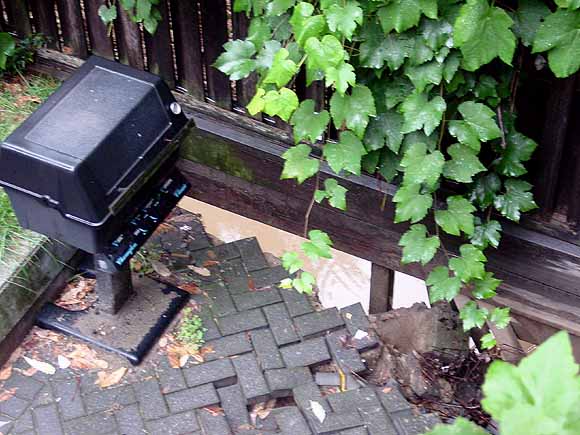
Here's another view: you can see the lake of water from a recent rain through the gap under the fence. It's amazing the fence is still standing.

And here's the view of the fence on the other side of the pit, two doors over from our building. Isn't America great? It's a place where you're free to be a business failure and there are always others to take up the slack--that's how much we value entrepreneurship. It wasn't always thus: in days of yore a posse of strong men from the neighborhood would have paid a visit on Mr. Budding Capitalist and stood there with arms folded till he filled in the hole with his own labor. But that would be fascistic, so we rely on the court system to do...nothing.
What is an art blog? 3
Chris Ashley has some questions/comments addressing the previous post. Taking them in order (now it reads like an interview):
Is it just me or did you rewrite th[e] post, and include more quotes?
I did a slight rewrite (I often tinker with posts after they're up; if it's substantive I put an UPDATE notice at the bottom).
Now that I look closer, it's funny to notice that the staples [in your piece] aren't big heavy staplegun-type staples used for stretching canvas; they look thin, like from an office stapler. Am I wrong? If I'm right, it's a sign, along with the office-standard colored copy paper, telling me that this "painting" has white collar origins. Did you photocopy this on the job? [...]
When I showed this body of work in the late 90s I used the phrase "corporate tramp art" in the press release but none of the writing picked up on that. Let's just say the work was an attempt to make lemonade, psychologically, out of an astringently toxic permatemp gig that has since mercifully ended. I'm doing similar work elsewhere (which is more enjoyable), so I feel I must add, "Of course no company supplies or materials were used." (The staples are actually light duty staples from an old Swingline gun.)
I'm interested in this quote from [yester]day: "...I do value the physical work (too)..." You've said in the past (Nov. 30, 03), "I like painting OK but I'm sick of the 'romance of paint.'" I'm curious, then, about this comment from a few days ago,"The only reason I'm pulling this out now is I reached a point with the computer-painting where I want to see more real world grit, and this older work is all about grit." I guess I'm wondering about what is the difference between the grit and romance, is paint always romantic, and what would paint add or detract from your recent work?
By "real world grit" I was referring to the legal pad, office paper, product boxes and such that I've incorporated into the work. For a while I've been working solely with computer-printed inkjet imagery and started thinking I needed to mix it up more with found stuff. The older work did a lot of layering between found and not-found.
[A]s I get back into painting after a hiatus (a long story), I am (and yes, I'm a "he") trying to figure out what I'm doing, what I want, where I'm going, and what I'm doing in the HTML drawings that is generalizable to other work. What I'm taking first from the HTML work is an approach to subject matter, a serial or a series approach, intentional transparency and overlay, a kind of gesture, and the notion of figure vs. field. And in my trying to figure this out I'm finding that it's really useful to post the drawings that I'm doing, to put them out for me to see, and for others, too. My weblog is, for me, a studio, a wall on which to post the work and reflect on it, a place for feedback, if I'm lucky, as well as a place to archive the work, write about art, link to interesting things, build arguments and interests over time.
This is the same thing I value in [your] weblog. I've also been paying attention to Dennis Hollingsworth's weblog, which I first found out about here, as well. I'm surprised that more artists don't use their weblogs as real workspaces for their art; most that I've seen are in the classic mold of a place to write, link, and gossip- journal-like spaces. What I don't see often enough are webloggers who mine their past posts, reflect on where they've been and where they are now, connect dots, and build a corpus of work. Am I missing others who are doing this?
As for painting, I have no plans to do it--I'm more interested in the problem-solving of how to make interesting, resonant, stand-alone objects with the computer, printers, photocopiers, etc., and intertwining that practice with purely online things like animated GIFs. There's more than enough there for a career. And for what it's worth, I much prefer your HTML drawings to the scanned sketches: the latter are "one step removed," but even more than that, having to work within the rigid cyber-parameters really toughens up and enlivens your output, for me. The online drawings seem very "now," whereas the sketches seem like a step back, even when I like the imagery. (Just so you know, I'm as bad as an ex-smoker about trying to talk people out of painting.)
As for art blogging, we discussed this issue a while back but I didn't address your comments specifically. I'll give my thoughts and then I'll post someone's slightly cynical (but thought-provoking) formulation from the previous round. First, the web is strewn with the carcasses of dead weblogs; it takes a particular kind of personality to keep posting, artist or no. Secondly, the web will mirror life: some artists will treat the contents of their studios like precious trade secrets and won't let anyone in while others will be very open.
In the previous round, artist and blogger twhid sent around a batch of questions about artists' blogging from someone researching the issue in Europe. In an email sent around to the group of initial respondents (which I'm publishing without permission and will remove if asked), Dyske Suematsu wrote:
There are probably many reasons contributing to the lack of interest in blogs in the art world. Here are some I can think of.I agree with some parts of this and disagree with others. It sounds a bit bitter, but there's a lot of truth there, there are definitely class things about the art world worth despising. I'm amused by the collectors who made piles in the tech sector seeking refuge in the art world as "the place of the sacred handmade."
1. Blog is a product of popular culture, and fine art is a product of high culture. Using blogs would devalue or take away this mystique of fine arts.
2. Many fine artists are not so computer savvy, and many among them are deliberately that way in order to distinguish themselves from the ordinary people who have to sit in front of computers all day at work. Artists need to keep the facade of being special and exceptional. They can't be doing what everyone else is doing.
3. Blatant self-promotion is looked down on in fine arts. Although the success in fine arts is largely defined by your skills for self-promotion, you must do so covertly. The Web in general is now seen as a marketing tool, and because of this, many artists, especially famous ones, do not bother building websites, much less Weblogs.
4. Artists could devalue their own work by speaking or verbalizing. Good artists are not necessarily good critical thinkers. If they were good at writing, and if writing is conducive to what they want to say, they probably would just write, instead of making something visual.
5. Fine art mainly caters to the taste of the upper class. The people of the upper class do not read weblogs. They are not so computer savvy either, because they can afford not to learn anything about computers; they just hire people to take care of computer-related tasks. In their homes, they often hide computers using elaborate pieces of furniture. They find them distasteful.
Later he added:
6. Fine arts is an interest of the privileged upper class. The rich and powerful do not like anything in which money cannot give them an advantage. Even for something as common as movies, they can arrange private, advanced screenings. For music, they can get prime seats at live concerts. Purchasing fine arts is the ultimate exercise of their privileges. For web-based art, however, they have no advantage. Absolutely anyone can view Net art from any computers. Digital art does not allow them to feel special and privileged, which is the main reason why they buy art in the first place. So, if you want to be a successful gallery-based artist, you need to address these upper-class concerns, and stay away from the interests of Philistines.
In the comments to an earlier post, a couple of people have been nice enough to help me with the ongoing issue of how to present work on the web. Sally (if I can paraphrase her) thinks a piece I posted earlier
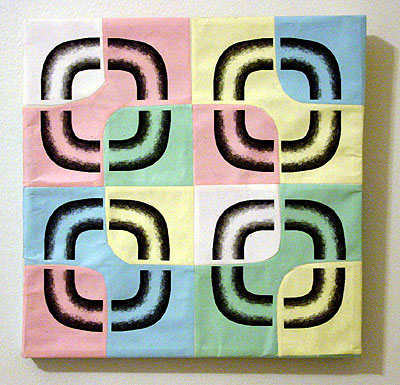
should be shown cropped and sharpened, so that it reads more as a web-friendly graphic,
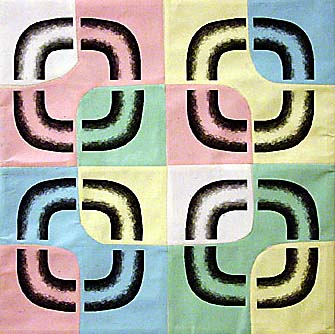
while Chris (if I can paraphrase him) was interested in what more documentation told him about the actual physical object. (The example below is the back of a different but similarly made piece.) "I like the simple use of materials- paper the colors found near a photocopier of any medium-sized office, and the linen tape, the bit of puckering. And what do you know?- it's a painting: a wooden stretcher and staples."
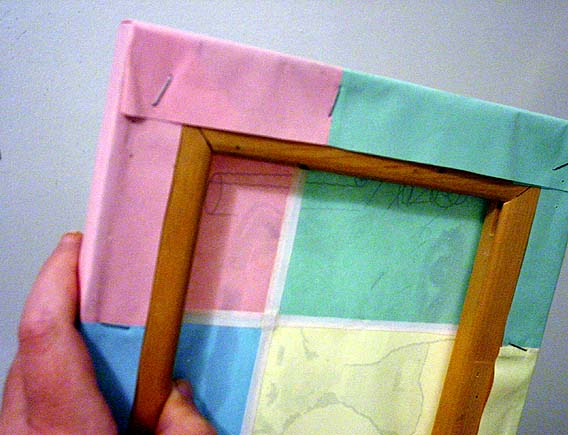
I'm actually not as intrigued as Sally by the grey zone between documentation of work and making some new, cyber-active form of it (again, paraphrasing)--in fact, I think the grey zone is a pain in the ass. You can choose to make things that demonstrably work best on the web (animated .GIFs, for example, or Chris's HTML drawings) but documenting physical work is basically a mundane, practical problem. Of course, new work ideas can be spun off from the process of documentation (and I like Sally's redo quite a bit), but I do value the physical work (too) and if the goal is to use the Web to make an end run around the gallery system, we really can't have the Web changing the meaning, or reading, of the objects on us.
Here's some straight-up re-reBlogging from yesterday. This is work by Gebhard Sengmuller (umlaut over the u, but it screws up my RSS feed), from Austria, as described on the we make money not art site. I wrote about an earlier Sengmuller project here. The image at the bottom I find incredibly compelling, even with (or maybe including) the glare.
VSSTV (Very Slow Scan Television) uses broadcasts from the historic public domain TV system --available anytime over freely accessible frequencies-- and regular bubble wrap to construct an analogous system in which the packing material works as the aperture mask.
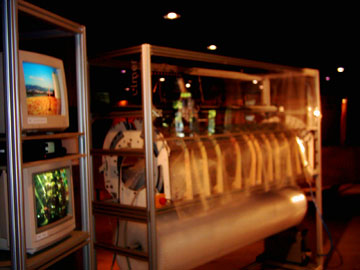
A plotter-like device fills a sheet of bubble wrap with pigments in the 3 primary CRT colors (red, blue, green), turning them into pixels on the VSSTV "screen." Observed from a distance, the cluster of pixels/bubbles will merge into the transmitted image.
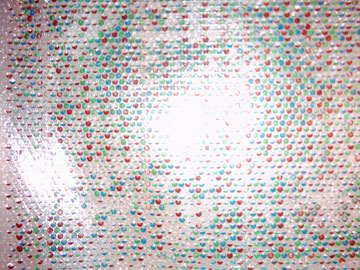
A patient observer can witness the extremely slow transformation of the "blank" bubble wrap into an image over the course of 10 hours.

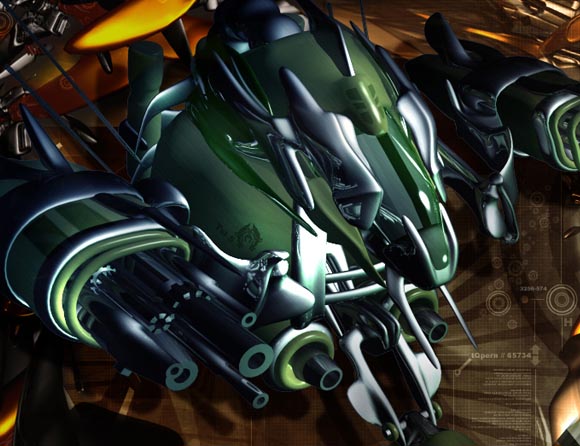
These are details of much larger works from the site depthCORE, which I came cross reBlogging. Later I'll post artist names and some critical thoughts; I just want to get them up. I wish I had a reBlog feed back to my own page, so I could keep a record here of what I'm finding while moonlighting. Suffice it to say, I'm the low tech guy and these are high tech: I'm actually opposed to what looks like obedience to one particular high-end program to make work (no idea which one). But the part of me that likes Moebius and Tron (and Tanguy, and Charles Sheeler) finds these pretty tasty. (Obviously they owe more allegiance to the gaming world and club graphics than the latter two names.) From the depthCORE mission statement:
depthCORE is an international digital art group, focusing on three dimensional and abstract art. Our members come from a wide demographic, united in their love for their art. We have a strong focus on collaborative works, as well as individual pieces. We are a non-profitable group.For the polar opposite of this work, see the next post.depthCORE was established in March of 2002 by ekud and altermind. Noticing an extreme lack of focus on 3D and abstract in the existing art groups within our community, they decided to form their own. Thus, depthCORE was born.
UPDATE: The top image is primitive robo facility by adesignprimitive; the bottom is Drone by shapero. Both are details.

Whether to see Collateral was a tough call: in the plus column, ultra-visual director Michael Mann, and in the minus, the pretty boy with elevator shoes. James Wolcott's prominently-placed blog recommendation tipped the scales, and the movie ultimately delivered with its delirious, film-length night ride through the back streets, office districts, and low-rent apartment parking lots of Los Angeles. It's palpably gorgeous filmmaking, constantly veering between highly subjective close-ups and unusual architectural angles. The plot [spoiler] is almost identical to Phone Booth's: a remorseless sociopath helps an everyday Joe get in touch with his inner feelings. A lot of it plays like a cop buddy film: the dialogue is sharp and funny but the story is the kind of thing that only happens in a Hollywood screenwriter's too-clever imagination. One funny subplot (OK, in a sick way) involves undercover detective Mark Ruffalo, who reprises the Scatman Crothers story line in The Shining. And, OK, the elevator shoes guy is serviceable (as opposed to his usual out and out bad) as a graying, brush-cut psycho.
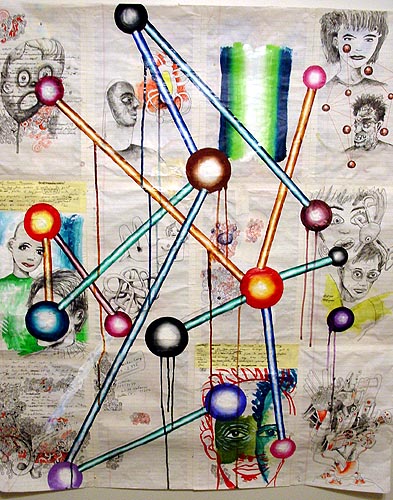
I have a lot of older work that got documented with a polaroid or not at all; using the digital camera means some of it is seeing the light of day. This was a piece from '96, one of the last of a series where I was taping legal pad sheets together and painting big dumb molecules on them. The doodles on the pad are pretty murky but trust me, you don't want to see them up close. I thought I was being funny channeling my inner high school student but the drawings are straight-up cringe-inducing. I paint the molecules on the computer now; I don't miss the carpal tunnel from painting them with real paint but the drips were fun to do. The only reason I'm pulling this out now is I reached a point with the computer-painting where I want to see more real world grit, and this older work is all about grit.
I'd been telling a NY musician friend about Chrome, a punk era band from San Francisco whose work is, I think, aging pretty well. Their super-dense acid guitar sound, layered with feedback and phase shifting effects, floating on top of metronomic or insistent beats, looked back to krautrock and anticipated both grunge and My Bloody Valentine. I played these tracks fom the late '70s/early '80s for my friend recently and he commented that they "don't sound dated at all--it could be a Williamsburg band." Check'em out:
"Innervacume" [.mp3 removed]--this is the most "punk" or post-punk track.
"3rd from the Sun" [.mp3 removed]--almost heavy metal, or proto-Soundgarden.
"Nova Feedback" [.mp3 removed]--the earliest and I think best of the three. Blues psychedelia--almost Hendrix-y a la "1983." No vocals is a big plus.
Posting will be light here for a few days while I learn to navigate the relentless bombardment of incoming data streams over at Eyebeam reBlog, where I am reBlogger of the Moment, starting today. The way it works is, they have umpteen blog-type sites coming in via RSS feeds, and I sift through new posts and present a daily selection of links. Thanks to Sally McKay for my quizzical head shot.
Chickenhawk-in-Chief
So I'm walking down 5th Avenue and fall in step with a man in a chicken suit.
"You're a chickenhawk, I take it?" I asked him, noting the belts of plastic ammo around his chest and the olive-drab helmet on his head.
"I'm the chickenhawk-in-chief," he says proudly, showing me the rubber George Bush mask he's not wearing at the moment and handing me a translucent blue plastic egg with a piece of paper in it.
"Any trouble from the cops?" I ask.
"No, as long as there's only one of me they can't do anything. I'm a lawyer, so I know if there were two other people with masks they could arrest us."
"What if you got up on a soapbox? I hear they busted a woman for that."
"I don't really need to speak; I think this costume says it all. I just walk up to where RNC delegates are and salute'em."
"Well, best of luck," I say. After he walks off, I unfold the piece of paper in the egg and find a couple of fatuous Bush quotes, including the famous "Our enemies are innovative and resourceful, and so are we. They never stop thinking of new ways to harm our country and our people, and neither do we."
This diptych was saved from Billmon's (currently dormant) page, shortly after the Vice President snarled "Fuck yourself" to a Democrat on the Senate floor:

Atrios pairs Cheney with an even madder mad dog here. I missed the speeches last night but it sounds like there was love in the air. Georgia Senator Zell Miller ranted about soldiers giving us (and the world) the Bill of Rights ("For it has been said so truthfully that it is the soldier, not the reporter, who has given us the freedom of the press...It is the soldier, not the poet, who has given us freedom of speech. It is the soldier, not the agitator, who has given us the freedom to protest"), which sounds like something from Starship Troopers, and Cheney told lie after lie about Kerry:
UPDATE: via drat fink, here's a good crib sheet correcting all the lies told by Cheney and Miller.[I]n this post-9/11 period, Senator Kerry doesn't appear to understand how the world has changed. He talks about leading a "more sensitive war on terror," as though al-Qaida will be impressed with our softer side. [Bush has used this term too, as in "we need to he sensitive to the needs of our allies" (such as the Turks, Pakistanis, etc.)] He declared at the Democratic Convention that he will forcefully defend America after we have been attacked. My fellow Americans, we have already been attacked, and faced with an enemy who seeks the deadliest of weapons to use against us, we cannot wait for the next attack. We must do everything we can to prevent it and that includes the use of military force. [Just like we scrambled those fighter jets on 9/11.] Senator Kerry denounces American action when other countries don't approve as if the whole object of our foreign policy were to please a few persistent critics. [Like, the whole world.] In fact, in the global war on terror, as in Afghanistan and Iraq, President Bush has brought many allies to our side. [Tonga!] But as the President has made very clear, there is a difference between leading a coalition of many, and submitting to the objections of a few. George W. Bush will never seek a permission slip to defend the American people. [Corny line.]
Senator Kerry also takes a different view when it comes to supporting our military. Although he voted to authorize force against Saddam Hussein, he then decided he was opposed to the war, and voted against funding for our men and women in the field. [Actually he opposed the same controversial $87 billion spending bill that Bush threatened to veto over the issue of "loans vs grants"] He voted against body armor, ammunition, fuel, spare parts, armored vehicles, extra pay for hardship duty, and support for military families. Senator Kerry is campaigning for the position of commander in chief. Yet he does not seem to understand the first obligation of a commander in chief and that is to support American troops in combat. [See previous comment.]
More on police bullying and incompetence in handling RNC demonstrators in this Newsday article. Apparently orange netting is the new tear gas:
Meanwhile, at Ground Zero -- a touchstone symbol in this year's presidential race -- a peaceful march turned sour as police strung orange nets at Vesey and Church streets, corralling 200 people including journalists and onlookers. Police Commissioner Ray Kelly blamed the Ground Zero arrests on march organizers "reneging on an agreement not to block traffic" and "failing to walk on sidewalk instead of street."As Tom Hayden puts it, "The protesters got in Karl Rove's sound bite...there have never been so many people protesting a political convention of the 80 in our history, and there have never been so many people arrested." Damn right about the sound bite. It was a good feeling after marching Sunday to see the protester crowd photo on the New York Post's front page. Especially since the picture of Dick Cheney's Ellis Island convention kickoff speech ran inside. Surely that would have been given bigger play if everyone hadn't turned out in such record numbers?But many detainees told reporters they were not aware of the rules. "They said as long as you observe the red lights, it shouldn't be a problem," said Bob Curley, who was arrested with his son. "Then we walked off the sidewalk and across the street and that was the end."
Good reporting on the continuing demonstrations and shitty police arrest tactics can be found at the Village Voice (Anya Kamenetz's blog). It's hard to read this stuff without getting a knot in your stomach. It sounds like the demonstrators are just doing their thing--demonstrating--and the police are provoking, tricking, manhandling, and otherwise being complete dicks. Perfect palace guards for the Republicans, to keep them feeling safe and secure in their bubble world. Safe and secure from dissent, that is.
